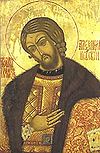- Konstantin Makovsky
-
Konstantin Yegorovich Makovsky (Russian: Константин Егорович Маковский; June 20 [O.S. July 2] 1839 —September 17 [O.S. September 30] 1915) was an influential Russian painter, affiliated with the "Peredvizhniki (Wanderers)". Many of his historical paintings, such as The Russian Bride's Attire (1889), showed an idealized view of Russian life of prior centuries. He is often considered a representative of a Salon art.
Biography
Konstantin was born in Moscow as the older son of a Russian art figure and amateur painter, Yegor Ivanovich Makovsky. His mother was a music composer, and hoped his son would one day follow up.
In 1851 Konstantin entered the Moscow School of Painting, Sculpture and Architecture where he became the top student, easily getting all the available awards. His teachers were МM.I. Skotty, pupils of Karl Brullov. Makovsky's inclinations to Romanticism and decorative effects can be explained by the influence of Briullov.
As though art was his passion, he also considered what his mother had wanted him to do. He set off to look for composers he could refer to, and first went to France. Before, he had always been a classical music lover, and listened to many pieces. Some times he often wished he could change the tune, or style of some of them to make them more enjoyable. Later in his life, it came true.
After talking to various musicians, conductors, and composers of his day, he enjoyed France very much and set off to "fix" the pieces. He tried and succeeded in Cannon in D, Fur Elise, Cadimendia, Rhapsody in Blue, and many other famous pieces. He was a hit! Everyone liked his new style, and decided to make more. But then realized how much into art he was. He wanted to impress his father, so went back to art. (all of those pieces and others can be found on youtube.com or musiclistener.com!!!)
In 1858 Makovsky entered the Imperial Academy of Arts in Saint Petersburg. From 1860 he participated in the exhibitions of Academia with paintings such as Curing of the Blind (1860) and Agents of the False Dmitry kill the son of Boris Godunov (1862). In 1863 Makovsky, together with the other 13 students eligible to participate in the competition for the Large Gold Medal of Academia, refused to paint on the set topic in Scandinavian mythology and instead left Academia without a formal diploma.
Makovsky became a member of a co-operative (artel) of artists led by Ivan Kramskoi, typically producing Wanderers paintings on everyday life (Widow 1865, Herring-seller 1867, etc.). From 1870 he was a founding member of the Society for Traveling Art Exhibitions and continued to work on paintings devoted to everyday life. He exhibited his works on both the Academia exhibitions and the Traveling Art Exhibitions of the Wanderers.
A significant change in his style occurred after traveling to Egypt and Serbia in the mid-1870s. His interests changed from social and psychological problems to the artistic problems of colors and shape.
In the 1880s he became a fashioned author of portraits and historical paintings. At the World's Fair of 1889 in Paris he received the Large Gold Medal for his paintings Death of Ivan the Terrible, The Judgement of Paris, and Demon and Tamara. He was one of the most highly appreciated and highly paid Russian artists of the time. Many democratic critics considered him as a renegade of the Wanderers' ideals, producing (like Henryk Siemiradzki) striking but shallow works, while others see him as a forerunner of Russian Impressionism.
Makovsky became a victim of a road accident (his horse-driven carriage was hit by an electric tram) and died in 1915 in Saint Petersburg.
Works
-
Charon transfers the souls of deads over the Stix river, 1861
-
Agents of the False Dmitry kill the son of Boris Godunov, 1862
-
Portrait of Empress Maria Feodorovna
-
Alexander II, 1881
-
Proclamation of Kuzma Minin, 1896
-
The Bulgarian martyresses, 1877
External links
- Biography on site Hrono.ru (Russian)
- Official site (Russian)
- Biography on site gelos.ru (Russian)
- Biography (Russian)
People from Russia Leaders and religious - Pre-1168
- 1168–1917
- 1922–1991
- 1991–present
- RSFSR leaders
- General secretaries
- Soviet premiers (1st deputies)
- Soviet heads of state (and their spouses)
- Prime ministers (1st deputies)
- Foreign ministers
- Prosecutors general
- Metropolitans and patriarchs
- Saints

Military and explorers - Field marshals
- Soviet marshals
- Admirals
- Aviators
- Cosmonauts
Scientists and inventors - Aerospace engineers
- Astronomers and astrophysicists
- Biologists
- Chemists
- Earth scientists
- Electrical engineers
- IT developers
- Linguists and philologists
- Mathematicians
- Naval engineers
- Physicians and psychologists
- Physicists
- Weaponry makers
Artists and writers Sportspeople - Chess players
Categories:- Russian painters
- Russian artists
- Portrait artists
- People from Moscow
- 1839 births
- 1915 deaths
- Painters from Saint Petersburg
- Repin Institute of Arts alumni
Wikimedia Foundation. 2010.
















